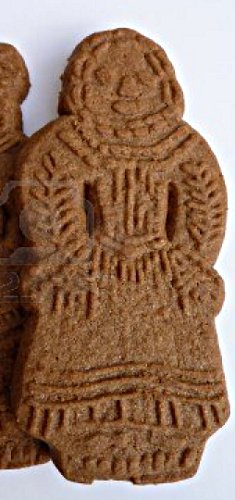Another one of the rare production dies for 6/7/8th century gold foil figures has come to light, again on Zealand! This is an unusual design depicting a lady from the front. She's wearing a long dress, a cloak and two bead strings. She seems to be cupping her hands around a ring at her abdomen. The rings on her dress hem are quite odd. Parallels to the general motif and design are known from Eketorp on Öland (a foil) and Sättuna in Östergötland (a die). Congratulations to detectorist Hans, and thanks for doing other folks with an interest in the past a big favour!
Update 4 Feb: Aard regular Kevin points out that this Vendel Period lady looks just like a Dutch Christmas cookie! Image from 123RF.


I've said it before, I'll say it again and I will say it in the future: liberalize the swdish metal detector legislation - and do it now!
It would be interesting to see digitalized, pehaps 3d, interpretations of these gold foil figues.
Gives the impression of a Völve. The rings, the extremely long hair - parted in the middle, not in the usual women's knotted tail... Wonderfully detailed, would love to look at it IRL...
Die...? I don't think so. I see it as an ordinary - but RARE - vikingage pendant, known with different female figurines... Am I wrong? - And Håkan: we all hope for the best, but fear the worst!
I haven't seen the back side but the finder says nothing about any fastening apparatus.
Claus, the piece measures only 30 by 15 mm.
I prefer to imagine them baking tiny speculaas: http://2.bp.blogspot.com/_LCVZWFAEodk/RXEM4EACTuI/AAAAAAAAACE/TUvr_edra…
Haha, awesome!
Hans the finder just wrote me to say that there is no trace of any fastener on the back side.
Any news about the unusual find ?
Are there any traces left of goldfoil ?
Are there hammermarks on the backside ?
Awesome nice find though ;-)
Is that a woman? The face looks rather masculine (I'm getting the impression of a beard and moustach, although that might just be the way they've carved the chin and wouth).
I believe those facial features are pretty unisex within the parameters of the period's art. The person's dress is solidly female.
Nice find. I also had the immediate association with a speculaasje. Which are the cookies for Sint Nicolaas (Sinterklaas) at December 5th, not for Christmas, btw.
I'm ashamed to admit that only this morning did I make the connection between the word "gubben", which my Norwegian cousin uses to refer to her husband, "gubberøre", one of my favorite edibles, and "gullgubbe" -- I had no idea it was gender-specific. I assume it started as a colloquialism and only later entered the academic lexicon. What would the female equivalent be -- gullkjerringa?
Yes, "guldgubbe/ar" is what 18th century farmers at Ravlunda called the foil figures they found eroding out of some coastal sand dunes and handed in to an academic. "Guldgumma/or" is what their female counterparts would be called in modern Swedish.